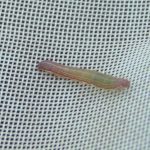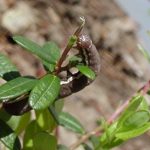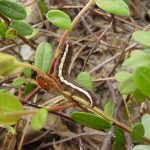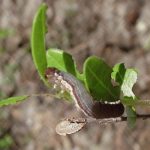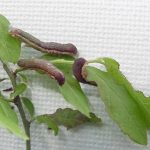Cranberry Blossomworm
Order: Lepidoptera || Family: Noctuidae
Scientific Name: Epiglaea apiata (Grote)
- Cranberry blossomworm caterpillar
- a mature Cranberry blossomworm larva feeding on cranberry foliage in a Maine cranberry bed
- Cranberry blossomworm caterpillar (they can vary in body color but they all have a white stripe)
- Cranberry blossomworm feeding on cranberry leaves in Maine
- Cranberry is preferred, but here is a pair of Cranberry blossomworm larvae feeding on some wild blueberry leaves (wild blueberry was substituted in captivity for cranberry when cranberry wasn’t readily available)
- Another view of Cranberry blossomworm larvae feeding on some wild blueberry leaves
Notes: This member of the cutworm group appears quite consistently each year on Maine cranberry beds, but rarely do its numbers—independent of other caterpillar pests—reach threshold levels [two exceptions to that occurred during the 2015 and 2019 seasons when numbers in the 30 to 100+ per 25 sweeps were being picked up]. When added to False Armyworm counts, however, the threshold for Maine growers is frequently surpassed. Each blossomworm that matures destroys many cranberry blossoms (while still in the bud stage), and once they are half grown, they switch from feeding during the daytime to feeding mostly at night. They overwinter as eggs, deposited singly in October on fallen leaves or pieces of dead vine on the floor of the bed. In Maine, they begin to hatch by the end of May; a few weeks later than that following a Late-Water (LW) flood. [See also pages 16-17 of Cranberry Insects of the Northeast by A.L. Averill & M.M. Sylvia (1998) – There is a nice photo of the moth on page 16 of that book. The moths are around during harvest.]
Sweepnet ‘First Dates’ (for detecting the young caterpillars in Maine): 6/2/2000, 6/8/01, 5/29/02, 5/24/06, 6/6/07, 5/14/09 and 5/27/2015 (Average of these = May 29th)
Control: For specific and current control recommendations for Maine, please refer to the Maine Cranberry Pest Management Guide.

